Ventilation in the steam room: examples of proven schemes and analysis of the rules of arrangement
A bathhouse on the site is an extremely useful building: to sit with friends and improve the body. But to maximize the effect, you need good ventilation in the steam room.
If this moment is missed during construction, the well-being of visitors to the bathhouse and the integrity of the building may suffer.
Let's try to understand the principles of functioning of ventilation, as well as how to properly equip forced ventilation in the sauna.
The content of the article:
Features of the functioning of natural ventilation
The ventilation of any living room should be organized correctly, and in relation to the bath, this is even more important. This room is characterized by increased humidity and sudden changes in temperature. If the air exchange is not balanced, then a sauna built from natural wood will need serious repairs in a couple of years.
In addition, without ventilation in the steam room there will be an extremely unpleasant and even hazardous microclimate: heavy air, mold, unpleasant odors, etc. The best for a Russian bath is natural ventilation, the organization of which does not require large expenses or complex construction skills.
As you know, warm air currents usually rise up, and downward movement is typical for cold air. The action of natural ventilation is based on this physical principle.
Cold air enters through the openings located below, heats up, rises up and is removed through the openings at the top.
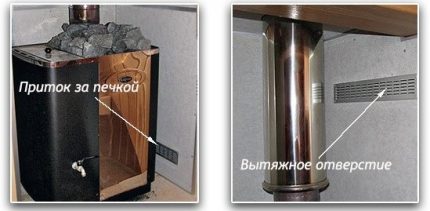
In order for this ventilation scheme in the steam room to work, a difference in the temperature of the air inside and outside is necessary. In ordinary living quarters with natural ventilation in the summer, problems can arise, since both rooms and the street are equally hot.
But in the bathhouse, due to the specifics of this building, it is not difficult to make such a difference, since the air constantly warms up during the bathing procedures.
If ventilation is thought out even at the construction stage, then special inlet openings will be provided in the lower part of the bath, and exhaust openings on the opposite side at the top.
But a special hole in the wall is not the only option for venting the bath. For example, in chopped baths, fresh air can be supplied through the crowns of the walls or simply through the door, which is left ajar for the period of ventilation.

Window vents, special vents, and even a chimney of a heating furnace are suitable for the role of the hood. If ventilation is through special openings, they must be properly designed. To begin with, all such objects should be covered with a protective grill.
And the shutters or other regulators that will allow you to adjust the air flow rate or completely block the ventilation hole will not interfere. The steam rooms are sometimes closed so that the room warms up quickly. But then you must definitely open them to restore air exchange.
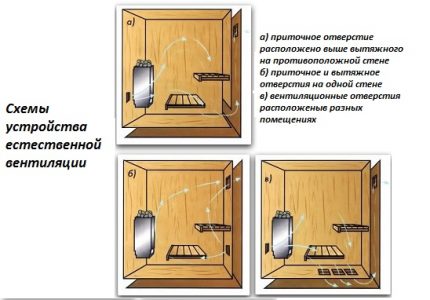
Choosing the most suitable scheme
If constant air exchange is assumed in living quarters, then in baths this is not always convenient, it all depends on the size of the bath and its internal structure.
Ventilation of Russian baths is carried out by the following methods:
- volley ventilation;
- exhaust through the chimney;
- the use of special holes.
Volley ventilation is a beautiful name for ordinary ventilation. This method is quite appropriate for a pair of small volumes. The idea is to periodically open windows and doors, thus creating conditions for intensive and short-term ventilation.
Of course, airing during the bathing procedures does not make any sense.
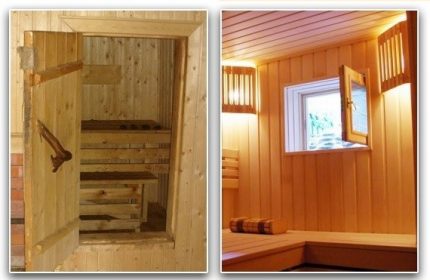
The room is ventilated at those moments when there is no one in the steam room, as well as at the end of the process. For airing, they simply open the window and the door to the steam room for just a few minutes.
During this period, the indoor air will be updated, and the surfaces will dry out a bit, and the steam room walls will not cool down, so visitors to the bath will not have any unpleasant sensations in the future. The possibility of volley ventilation should be provided at the stage of construction of the bath.
Opposite the door, a window with a window should be made so that air exchange is carried out correctly. Ideally, the door should be made in the corner, and the window should not be placed opposite, but diagonally and as close to the ceiling as possible. For volley ventilation to be effective, you just need to not forget about it. They took a steam bath, took a couple of minutes to air and we can safely continue the procedure.
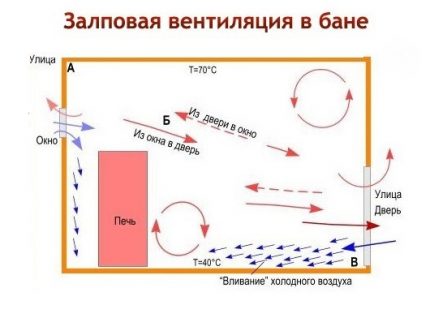
The removal of exhaust air through the chimney assumes the presence of a stove or other suitable device with a chimney channel. In such a furnace there is a blower through which exhaust air is discharged.
But for the effective operation of this scheme, you need to make sure that enough fresh air enters the room.

Slots in the logs are specially left in the lower rims of the walls, an alternative is a small one, only 10-15 mm gap under the door to the steam room. If there are no such gaps, and you don’t want to mess with their organization, just leave the door to the steam room a bit ajar.
Another important condition for organizing the exhaust through the chimney is that the stove must burn all the time, otherwise the air will not be removed, and accordingly, the inflow will be limited. If there is only a stove in the bath designed for short-term operation, you will have to choose a different ventilation method.
A universal way to organize natural ventilation in the bath is to make special openings for this - vents. In this case, ventilation will be carried out without obstacles, and you can control the intensity of air flow using special dampers or adjustable grilles.
The air in the steam room will be gradually updated. The optimum is the rate of air exchange in the region of five or six volumes of the room every hour. Of course, such ventilation must be properly designed and installed so that there are no drafts in the room.
So, you will need to make two holes: supply and exhaust. The cross-sectional area of these openings should vary slightly, the hood in the bath should be larger than the inflow. You can make one inlet and two exhaust.
The location of the inflow and exhaust should be done on opposite walls and in corners located diagonally.
In this case, the exhaust hole is best done under the ceiling itself, higher than the upper shelf, and the supply should be below, about 30 cm from the floor level. The inflow is best carried out as close as possible to the stove or even behind it, so that the air flows from the street have time to warm up.
What will happen if you neglect these recommendations and make holes at about the same level? Nothing good, i.e. draft. Streams of air will cross the room too quickly, and fresh air will simply leave the steam room immediately. It is clear that the effectiveness of such ventilation leaves much to be desired.
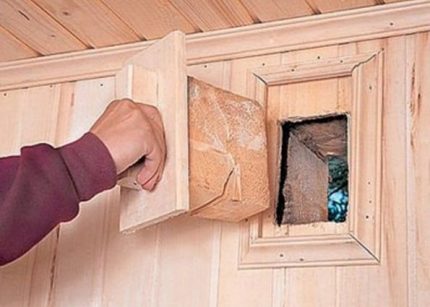
Do not make holes for the exhaust and inflow on the same wall, this will also negatively affect the air exchange.In order to get a sufficient air flow, a round hole is usually made in the wall of the bath for a pipe with a diameter of 100-200 mm.
For the hood you will need to make the opening a little larger. You can use a pipe with a slightly larger diameter or two smaller pipes. The main thing is that the total cross-sectional area corresponds to the calculations.
On our site there are several more articles about the rules for arranging ventilation in the bath, we recommend reading:
- Ventilation device in the bath: technical options and popular schemes
- Ventilation in the bath: an overview of the traditional schemes and nuances of the device
How to make vents for ventilation?
Installation of ventilation in the bath is as follows:
- In the selected places, holes are made of such a size that the pipe or duct freely passes into it.
- The space around the pipe is closed up so as not to violate the tightness of the room.
- Outside, the holes are closed with bars.
- Inside install special dampers or adjustable grilles.
It looks simple, but it is worth considering some points. For example, ventilation openings can be made not only round, but also square or rectangular with approximately the same cross-sectional area. In wooden baths, instead of plastic or steel pipes, wooden boxes are placed.
In this case, the choice of a hole in a rectangular configuration looks logical, because such a box is easier to make from ordinary boards.
Ventilation is best planned at the design stage so that you do not have to hollow the finished wall. Ventilation openings that face the street should be further protected with nets to protect against insects. The cross-section of the supply air vent in the bath is calculated based on the standard: 24 sq. cm section for each cubic meter of ventilated space.
Thus, for a bath of 12 cubic meters. m. you need a hole with an area of 284 square meters. see. If you plan to make a round hole, then its radius is calculated by the inverse formula of the area of the circle. The resulting indicator is divided by 3.14 (the number "pi"), from the result we extract the square root.
In our example, we get a radius of about 9.5 cm, and its diameter is 19 cm. Exact observance of the dimensions in this case is not relevant, so a pipe with a cross section of 200 mm is quite suitable. Or you can take two pipes of 100 mm. If the ventilation cross section is square, the approximate dimensions will be 17X17 cm.
Natural ventilation has undeniable advantages. Its installation is simple and relatively inexpensive, the operation does not require energy costs or the installation of special devices. The simple design guarantees no breakdowns and a long service life of the ventilation system.
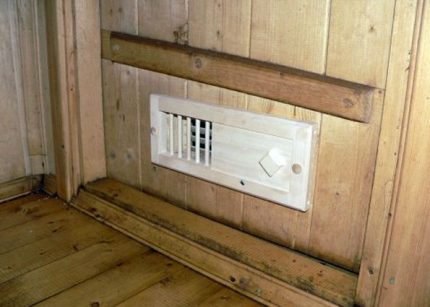
In winter, due to a significant difference in temperature inside the steam room and outside, the draft can noticeably increase. This can cause slight discomfort due to the fact that the air flows too quickly. In addition, odors that are not always pleasant can also enter the bathhouse from the outside. Regulation of the ventilation flow allows solving problems of this type.
The need for forced ventilation
Forced ventilation in the bath is extremely rare. Usually it is used in large complexes with a large steam room, pool, etc. But in a standard-sized bathhouse, such methods are used in cases where for some reason natural ventilation does not work too well or does not work at all.
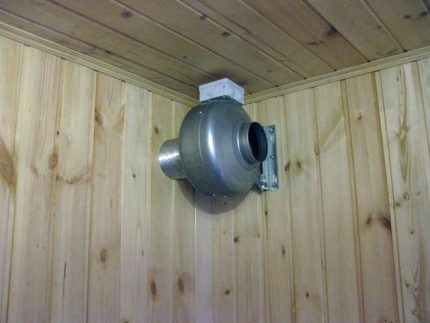
To correct the situation, and turn natural ventilation into forced ventilation, it is enough to put the supply fan in the corresponding hole or exhaust - on the hood. Both fans are usually not installed at the same time; complex supply and exhaust ventilation is used only at large facilities. And in a normal bath, a mechanical exhaust is sufficient.
If the air is forcibly removed from the room, fresh streams will occupy the vacated space in accordance with the laws of physics. In large bath complexes, everything is a little more complicated. At such facilities, the air exchange rate is first calculated, a ventilation system is designed, and fans of suitable power are selected.
For a small steam room, an ordinary, not too powerful fan is also suitable, which can be purchased at the store. Some craftsmen even make mechanical hoods using a cooler from the old system unit. Here is a simple example of calculating the fan power for a regular bath.
Let's say there is a room with an area of 9 sq.m. with a ceiling height of 2 m. The volume of such a room is 18 cubic meters. m. The multiplicity of air exchange recommended for baths is five. Multiplying the volume of the room by the rate of air exchange, we obtain the necessary capacity of the exhaust fan - 90 cubic meters. m / h
It is allowed to use a fan with a slightly higher power, but you should not be too zealous, otherwise the air exchange will become too intense. If there is a desire to modernize forced ventilation in the bath, you can set a timer so that the device automatically turns on at certain specific intervals.
Using appropriate sensors, you can configure the inclusion of ventilation when the specified air temperature or humidity is reached. But in an ordinary bathhouse such difficulties are usually unnecessary.
A few words about sauna ventilation
Above, ventilation options for a regular Russian bath are described. In the sauna, everything is arranged a little differently. Only forced or combined ventilation is acceptable here. In small saunas, the latter is more appropriate, namely, a mechanical hood.
The main task when ventilating the sauna is to make sure that the flow of cold air warms up quickly and spreads smoothly throughout the room.
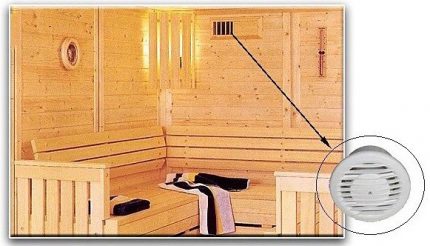
Even a hint of a draft is categorically unacceptable, since the effect of soaring will lose all its charm. Therefore, the size of the supply air hole is calculated according to the above scheme, and the hole itself is placed strictly behind stovesto provide fast, almost instantaneous warming of the air flow.
The exhaust outlet can still be located in the opposite corner of the room under the ceiling, however, with an exhaust fan, this requirement is not so strict. There are situations when the sauna room has only one external wall, through which both fresh air intake and removal of exhaust air masses is carried out.
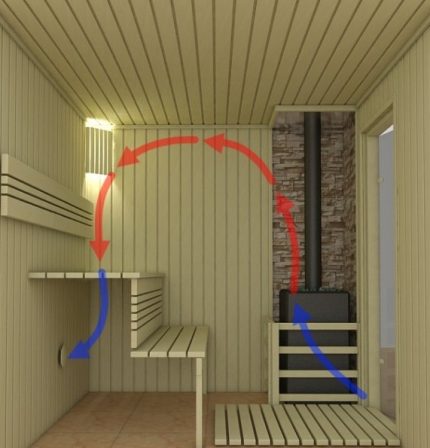
In this case, it is recommended to make a supply opening at a level of about 20 cm from the floor, but it should be located strictly behind the heater. The hood is placed on the opposite edge of the wall all the same - under the ceiling. The stream of cold air will warm up and move around the circumference along the walls of the room, gradually mixing with the rest of the air in the sauna.
This order will provide the necessary air exchange and keep the air temperature at an acceptable level.To achieve the fastest possible air exchange, use the so-called high-speed circuit. The inlet is made as usual - 20 cm from the floor level. At the same level, a mechanical hood is installed from the floor, only it is mounted on the opposite wall.
Hot air rises to the ceiling of the sauna, where it cools down, falls down along the opposite wall and leaves through the exhaust hole. Ventilation is quick and the change in air temperature is almost not felt.
The softest mixing of fresh air from the street and warmed air masses indoors can be achieved by installing an air inlet at a level of about 50 cm, but still in close proximity to the heater. The hood is placed near the floor at a height of 20 cm. The ventilation rate in this embodiment is slightly lower than when using other schemes.
For information on how to organize the ventilation of a sauna with an electric heater, read this stuff.
Conclusions and useful video on the topic
Detailed and interesting information about the principles of ventilation of the steam room is described here:
Undoubtedly, ventilation in the bath is necessary. Only with proper air exchange bath procedures will really bring real health benefits to visitors, and the owners of the building will be spared the additional costs of mold control and maintenance.
Have questions about arranging ventilation in the sauna? Or, perhaps, you yourself have been involved in arranging this system and can you share experience with visitors to our site? Please leave your comments in the box below.

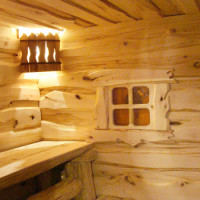 Ventilation in the bath: an overview of traditional schemes and nuances of arrangement
Ventilation in the bath: an overview of traditional schemes and nuances of arrangement  Inspection pit ventilation in a garage: specifics of arranging an air exchange system
Inspection pit ventilation in a garage: specifics of arranging an air exchange system  Basement ventilation in a private house: the best ways to arrange proper air exchange
Basement ventilation in a private house: the best ways to arrange proper air exchange 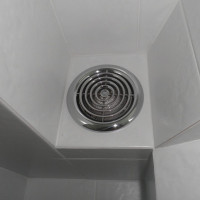 Connecting an exhaust fan in the bathroom and toilet: analysis of schemes and tips for installing equipment
Connecting an exhaust fan in the bathroom and toilet: analysis of schemes and tips for installing equipment 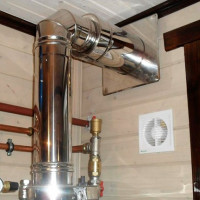 Ventilation for a gas boiler in a private house: arrangement rules
Ventilation for a gas boiler in a private house: arrangement rules 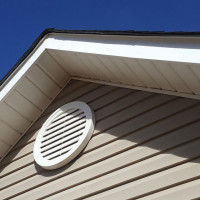 Ventilation in a private house through the pediment: arrangement options
Ventilation in a private house through the pediment: arrangement options  How much does it cost to connect gas to a private house: the price of organizing gas supply
How much does it cost to connect gas to a private house: the price of organizing gas supply  The best washing machines with dryer: model rating and customer tips
The best washing machines with dryer: model rating and customer tips  What is the color temperature of light and the nuances of choosing the temperature of the lamps to suit your needs
What is the color temperature of light and the nuances of choosing the temperature of the lamps to suit your needs  Replacement of a geyser in an apartment: replacement paperwork + basic norms and requirements
Replacement of a geyser in an apartment: replacement paperwork + basic norms and requirements
I only have the so-called volley ventilation. Except for the window and door did not provide anything more. But I can say: this is quite enough. I have a small steam room. Squares eight from the force. But enough for our family. I equipped it in a former capital barn. I did everything with my own hands, we have been using it for almost two years now, we are happy with everything.
We also have our own bathhouse. Steam every week. I believe that volley ventilation is the most affordable and simple. There is no need to think up what and how to make sure that the steam room is ventilated. And so they steamed, opened windows, doors. Everything is weathered and you have no mold and fungi. For several years we have been using the bathhouse, and everything is fine, it’s worth as good as new.
Experienced guys built a bathhouse for us several years ago. They themselves advised volley ventilation. We didn’t understand much then, we simply trusted the builders. Now we understand that we did not miss. The bathhouse is not particularly monitored and not aired. We take a steam bath once a week. Over all these years, no dampness or mold has appeared. Satisfied with the result. In my experience, volley ventilation is the most practical. Well, and there, of course, a matter of taste.
And I did to clients as in the second option, i.e. the inflow behind the boiler, and the exhaust duct opposite in the corner. Plus two adjustable holes - one under the ceiling, and the second under the shelves. When you steam the upper one is closed, the lower one is open, when you air it, then the upper one is opened, and the lower one is closed. Four years already use, steam room as new (use intensively)!